NEWS
George Floyd Protests in Washington, DC
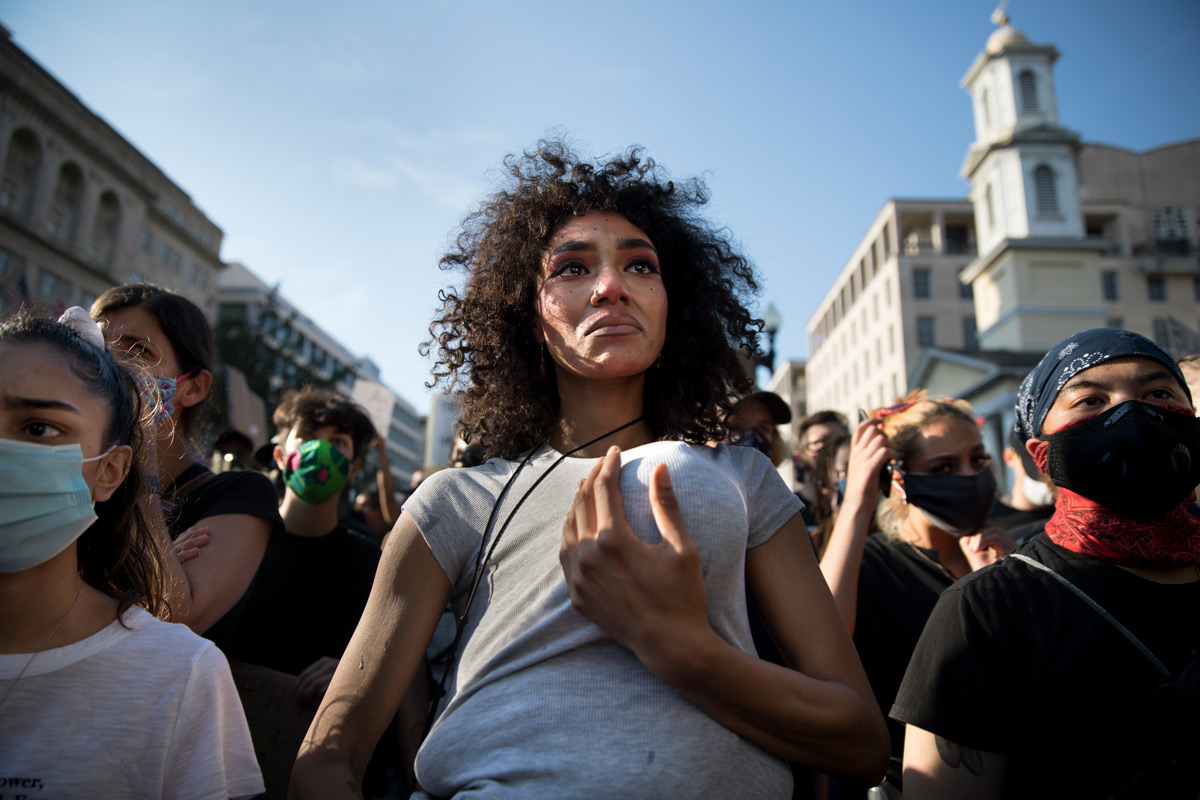
"I think it's important for me to do this now so my daughter doesn't have to do this in 15 years," said Twana Buck who brought her one-year-old daughter Bonita Buck-Parker to the George Floyd protests near the White House in Washington, D.C., on Tuesday, June 2, 2020. Buck was hoping that her daughter's presence would calm the protesters and law enforcement, but within minutes after arriving to the front line, she found herself and her daughter sprayed with chemical gas so, trembling, she backed away with her daughter protectively tucked under her shirt. Floyd, a black man, died last week when a white police officer held his knee on the man's neck during an arrest in Minneapolis. After the previous day's aggressive tactics by law enforcement to clear Lafayette Park so Trump could have a photo op, the day passed relatively peacefully with several thousand demonstrators chanting and taunting the officers.
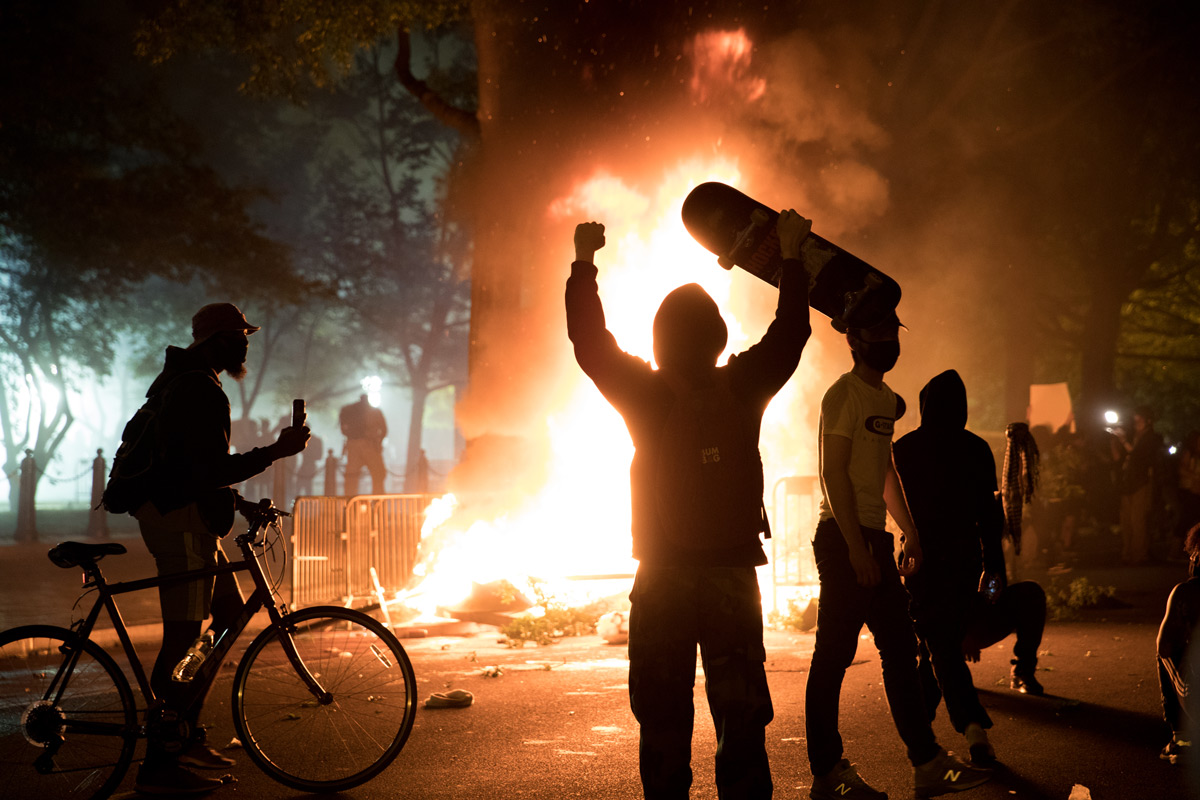
Protesters dance and cheer after setting a large fire near the White House in Washington, D.C., on Sunday, May 31, 2020. The death of George Floyd in Minneapolis last week has ignited nationwide protests. Floyd, a black man, died when a white police officer held his knee on the man's neck during an arrest. Protesters set cars, shops and the historic St. John's Church on fire and law enforcement shot tear gas, fireworks and used pepper spray against the crowds.
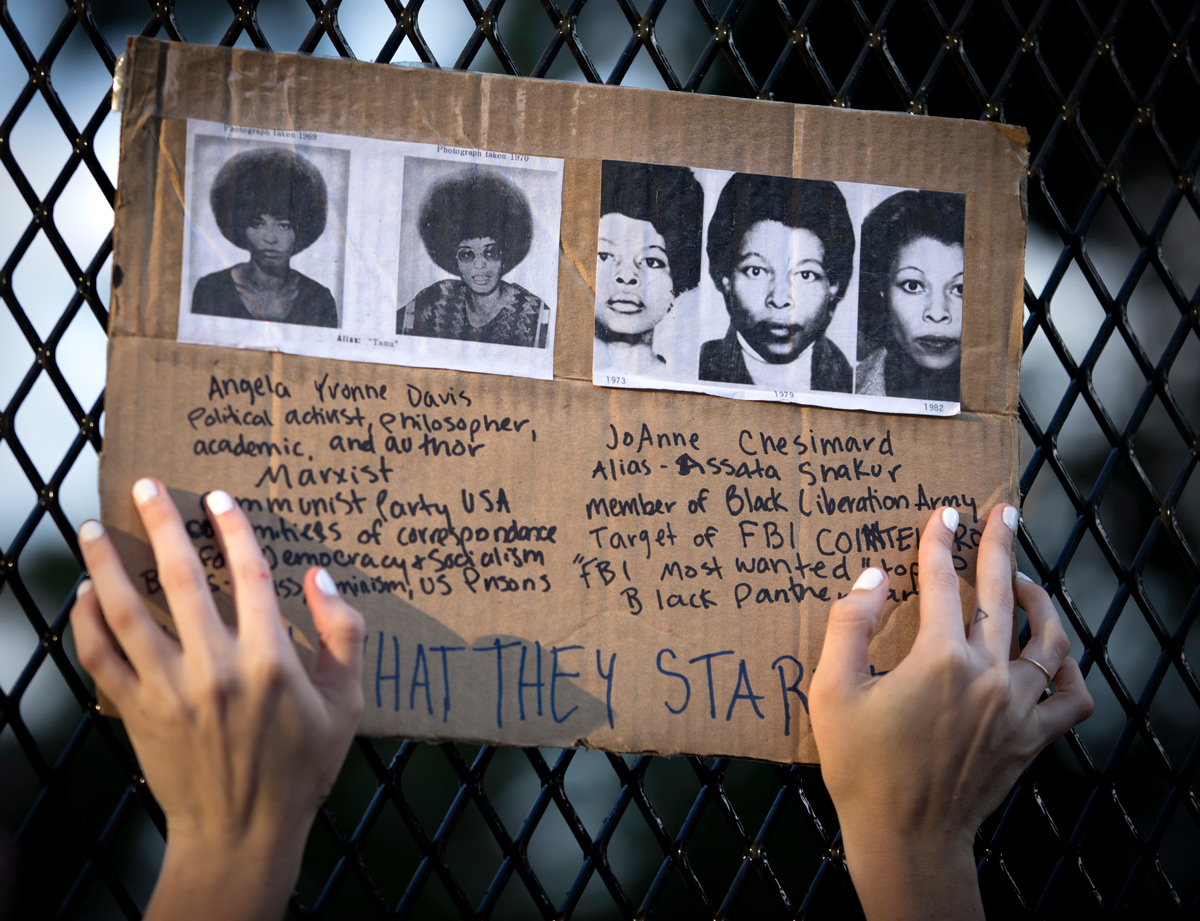
George Floyd protests have gripped the nation's capital near the White House in Washington, D.C., on Tuesday, June 2, 2020. Floyd, a black man, died last week when a white police officer held his knee on the man's neck during an arrest. After yesterday's aggressive tactics by law enforcement to clear Lafayette Park so Trump could have a photo op, the day passed relatively peacefully with several thousand demonstrators chanting and taunting the officers.
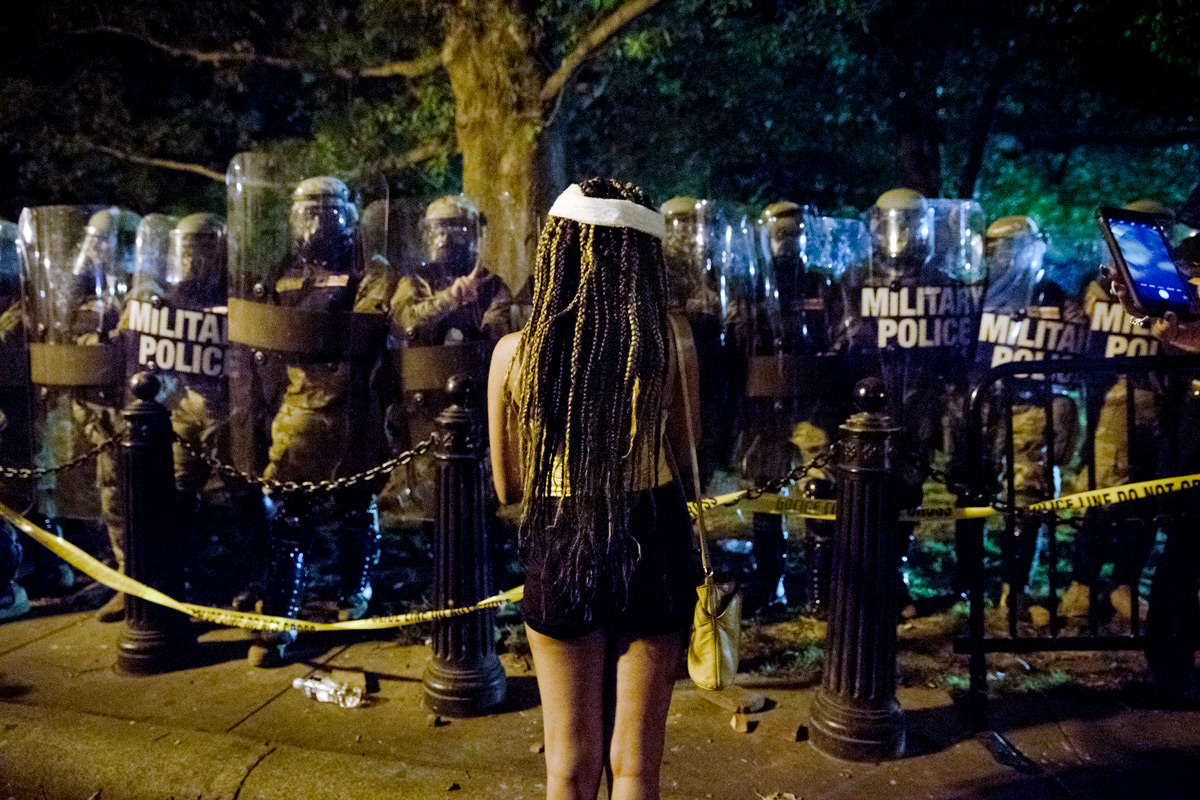
After a bloody injury from being hit in the head with a pepper pellet at close range, Taylor Lukas, 20, of Bladensburg, Md., returns to the police line to protest. The death of George Floyd in Minneapolis ignited protests around the country including near the White House for a second night, in Washington, D.C., on Saturday, May 30, 2020. Floyd, a black man, died when a white police officer held his knee on the man's neck during an arrest. Protesters broke store windows, set garbage bins on fire and threw water bottles at law enforcement who shot tear gas, fireworks and used pepper spray against the crowds.

George Floyd protests have gripped the nation's capital near the White House in Washington, D.C., on Tuesday, June 2, 2020. Floyd, a black man, died last week when a white police officer held his knee on the man's neck during an arrest. After yesterday's aggressive tactics by law enforcement to clear Lafayette Park so Trump could have a photo op, the day passed relatively peacefully with several thousand demonstrators chanting and taunting the officers.
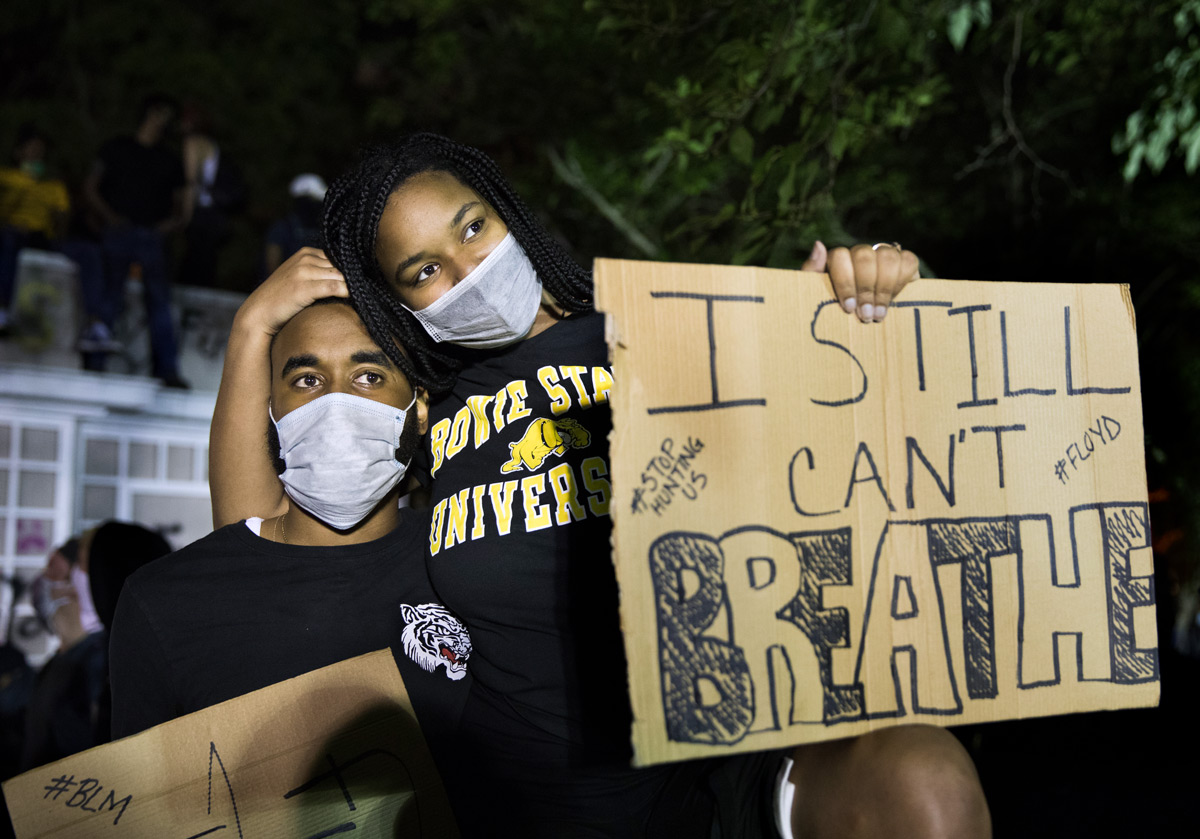
Natay Johnson, right, hugs Tay Smith, both of Washington, as they protest the death of George Floyd in front of the White House with some 10,000 other protesters in Washington, D.C., on Sunday, May 31, 2020. Floyd, a black man, died when a white police officer held his knee on the man's neck during an arrest in Minneapolis. Protesters set cars, shops and the historic St. John's Church on fire and law enforcement shot tear gas, fireworks and used pepper spray against the crowds.
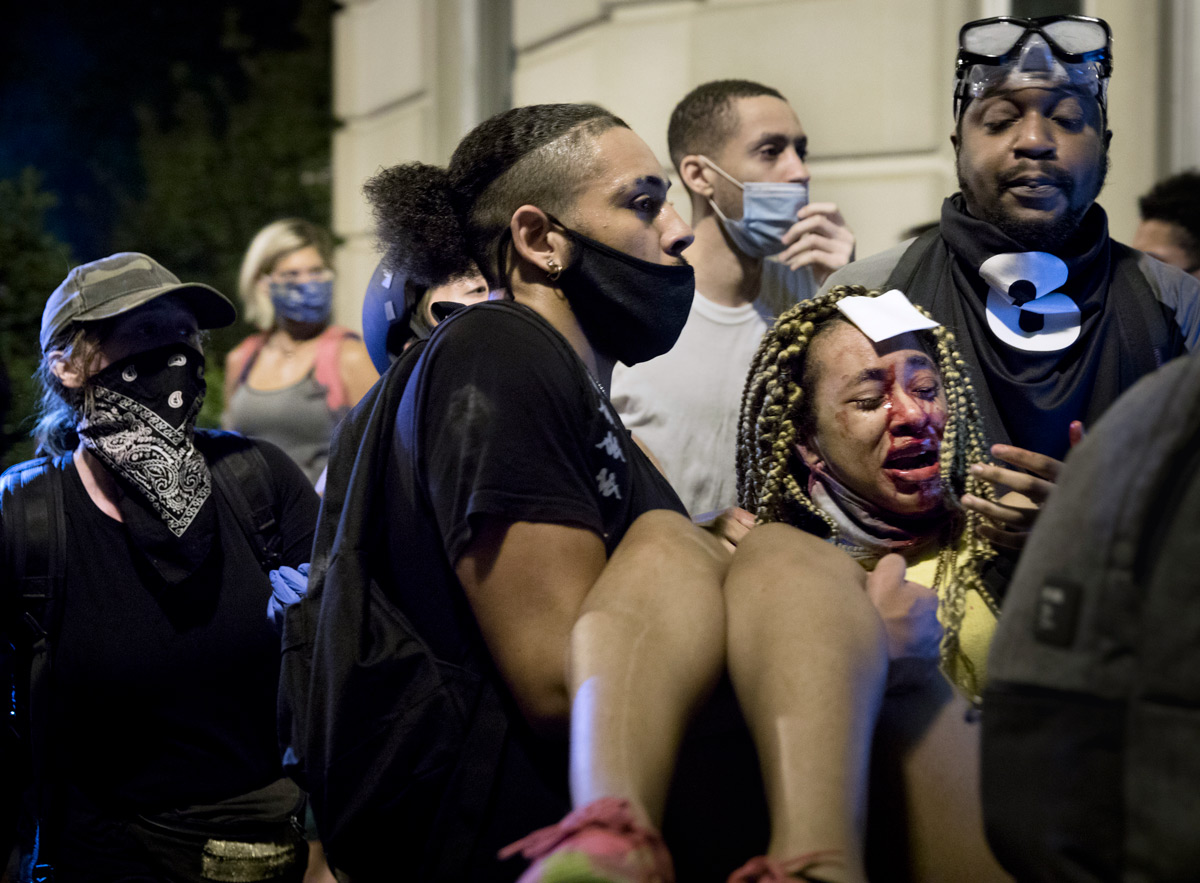
Taylor Lukas, 20, of Bladensburg, Md., wails as she is carried away from the police line after being hit in the head with a pepper pellet at close range. The death of George Floyd in Minneapolis has ignited protests around the country including near the White House for a second night, in Washington, D.C., on Saturday, May 30, 2020. Floyd, a black man, died when a white police officer held his knee on the man's neck during an arrest. Protesters broke store windows, set garbage bins on fire and threw water bottles at law enforcement who shot tear gas, fireworks and used pepper spray against the crowds.
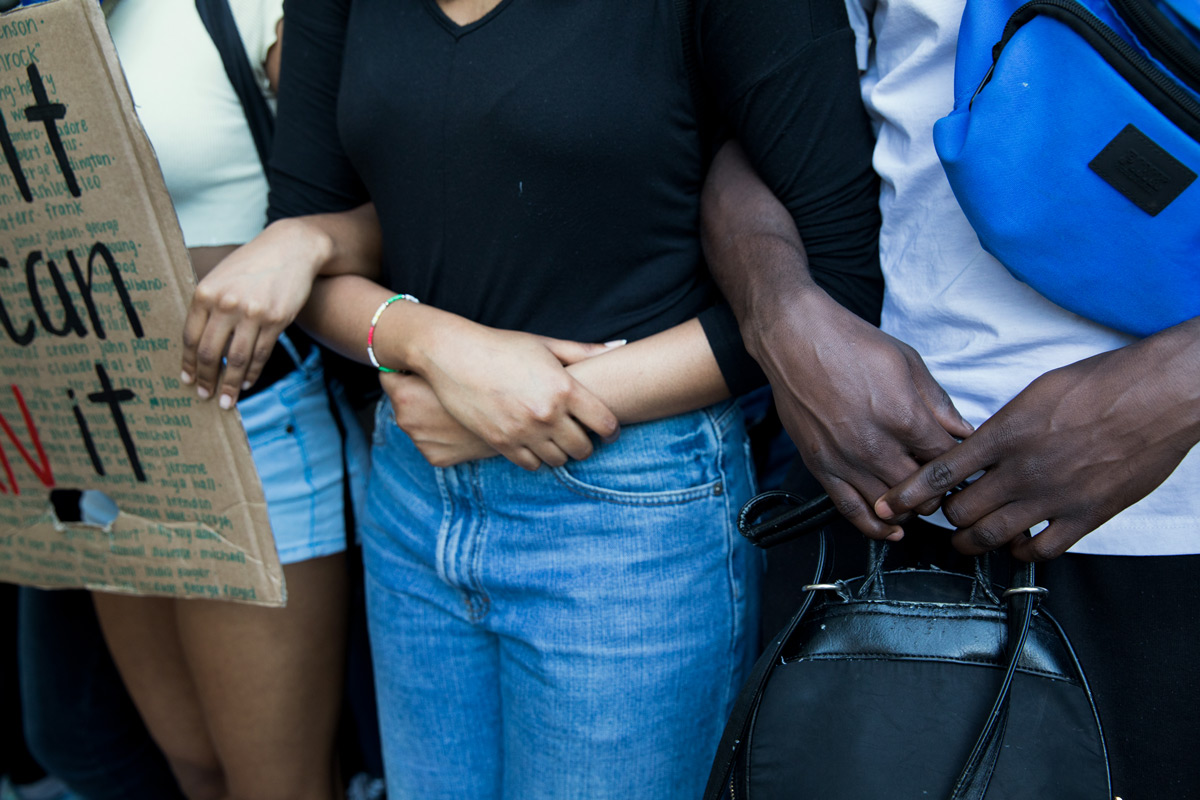
Protesters lock arms as they demonstrate against the death of George Floyd and police brutality near the White House for a third night, in Washington, D.C., on Sunday, May 31, 2020. Floyd, a black man, died when a white police officer held his knee on the man's neck during an arrest in Minneapolis. Later in the night, protesters set cars, shops and the historic St. John's Church on fire and law enforcement shot tear gas, fireworks and used pepper spray against the crowds.
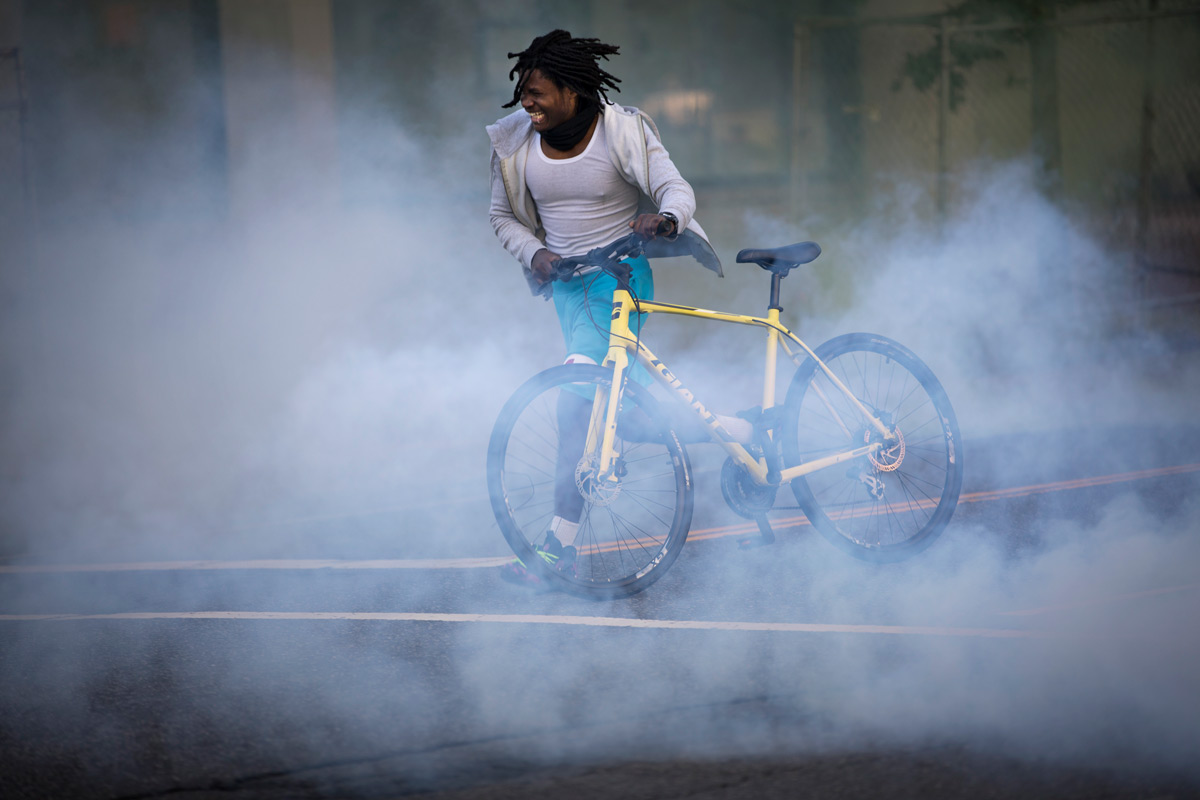
A man tries to outrun the chemical gas fired at demonstrators protesting the death of George Floyd near the White House in Washington, D.C., on Monday, June 1, 2020. Floyd, a black man, died when a white police officer held his knee on the man's neck during an arrest in Minneapolis last week. The military police, National Guard and Washington police aggressively shoved demonstrators and fired stun grenades, sting balls and chemical gas to drive them away from the White House where President Trump then walked to St. John's Church for a photo op.

Protesters break a window and set fire to businesses near the White House in Washington, D.C., on Sunday, May 31, 2020, in response to the death of George Floyd in Minneapolis last week. Floyd, a black man, died when a white police officer held his knee on the man's neck during an arrest. Protesters set cars, shops and the historic St. John's Church on fire and law enforcement shot tear gas, fireworks and used pepper spray against the crowds.
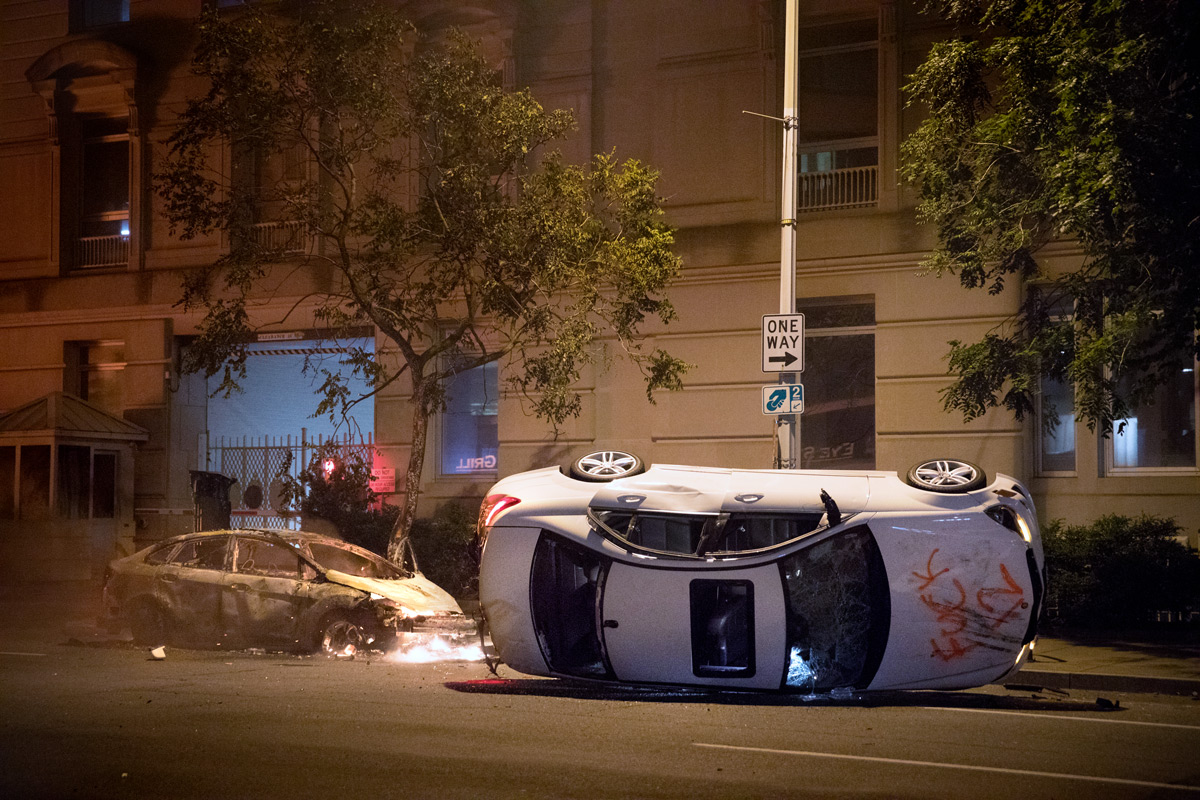
Two cars are damaged and torched by protesters after the death of George Floyd ignited nationwide protests including near the White House for a third night, in Washington, D.C., on Sunday, May 31, 2020. Floyd, a black man, died when a white police officer held his knee on the man's neck during an arrest in Minneapolis last week. Protesters set cars, shops and the historic St. John's Church on fire and law enforcement shot tear gas, fireworks and used pepper spray against the crowds.
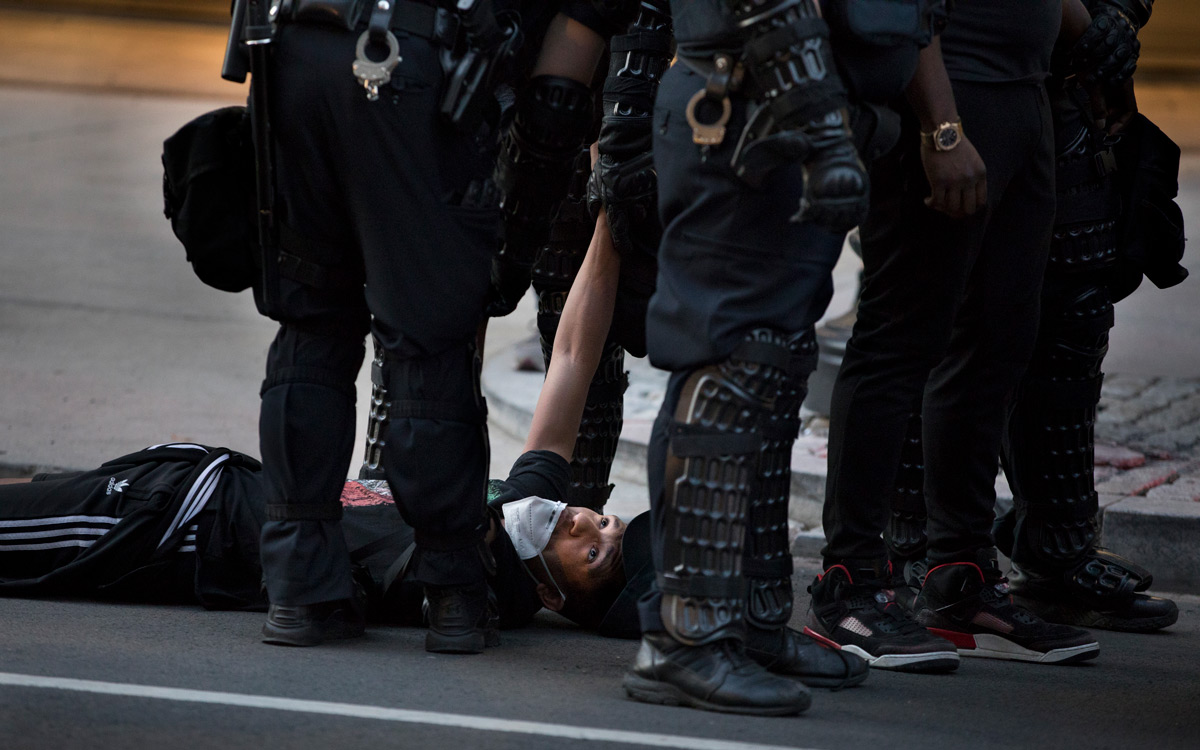
Near the White House, demonstrators peacefully protesting the death of George Floyd are encircled by the police and eventually arrested in Washington, D.C., on Monday, June 1, 2020. Floyd, a black man, died when a white police officer held his knee on the man's neck during an arrest in Minneapolis last week. The military police, National Guard and Washington police aggressively shoved demonstrators and fired stun grenades, sting balls and chemical gas to drive them away from the White House where President Trump then walked to St. John's Church for a photo op.

The death of George Floyd in Minneapolis ignited protests around the country including near the White House for a second night, in Washington, D.C., on Saturday, May 30, 2020. Floyd, a black man, died when a white police officer held his knee on the man's neck during an arrest. Protesters broke store windows, set garbage bins on fire and threw water bottles at law enforcement who shot tear gas, fireworks and used pepper spray against the crowds.
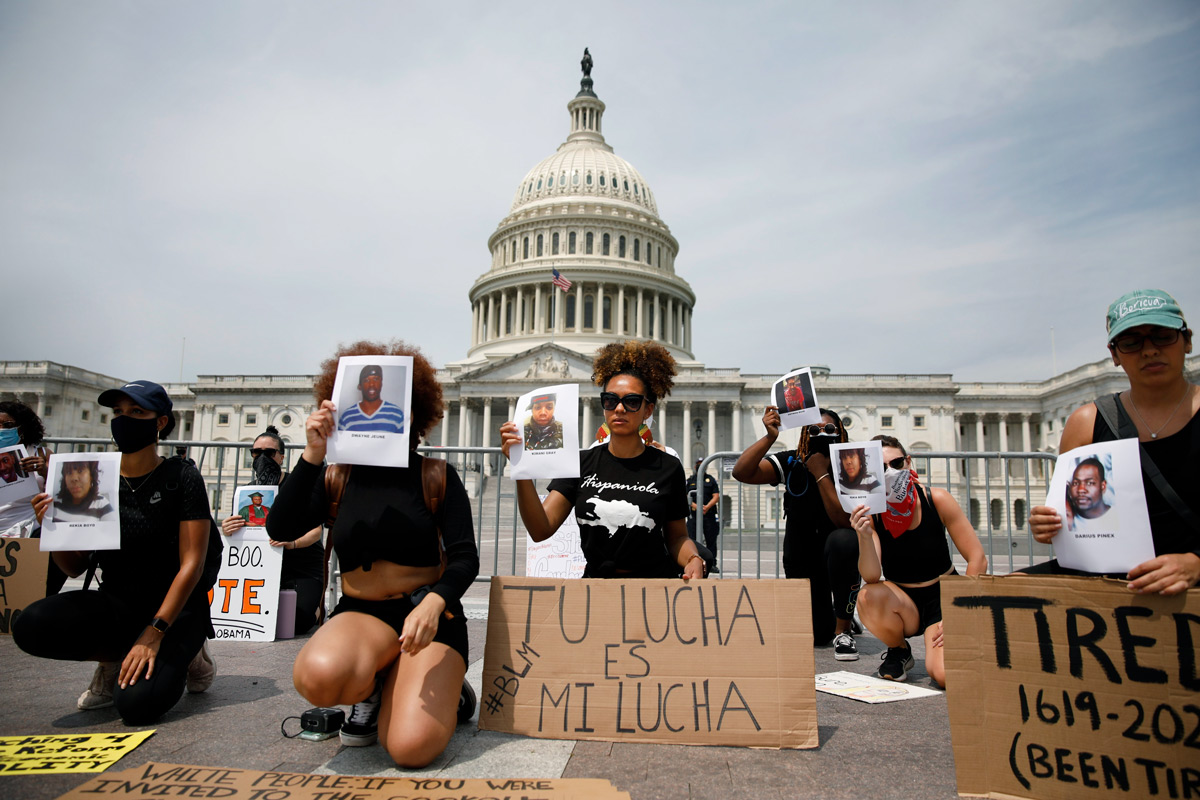
Protesters Heyssis Castillo and Katherine Bonilla, center left and right, demonstrate against the death of George Floyd and police brutality in Washington, D.C., on Saturday, June 6, 2020. Floyd, a black man, died May 25 when a white police officer held his knee on the man's neck during an arrest in Minneapolis. His death has sparked demonstrations throughout the country and the world.
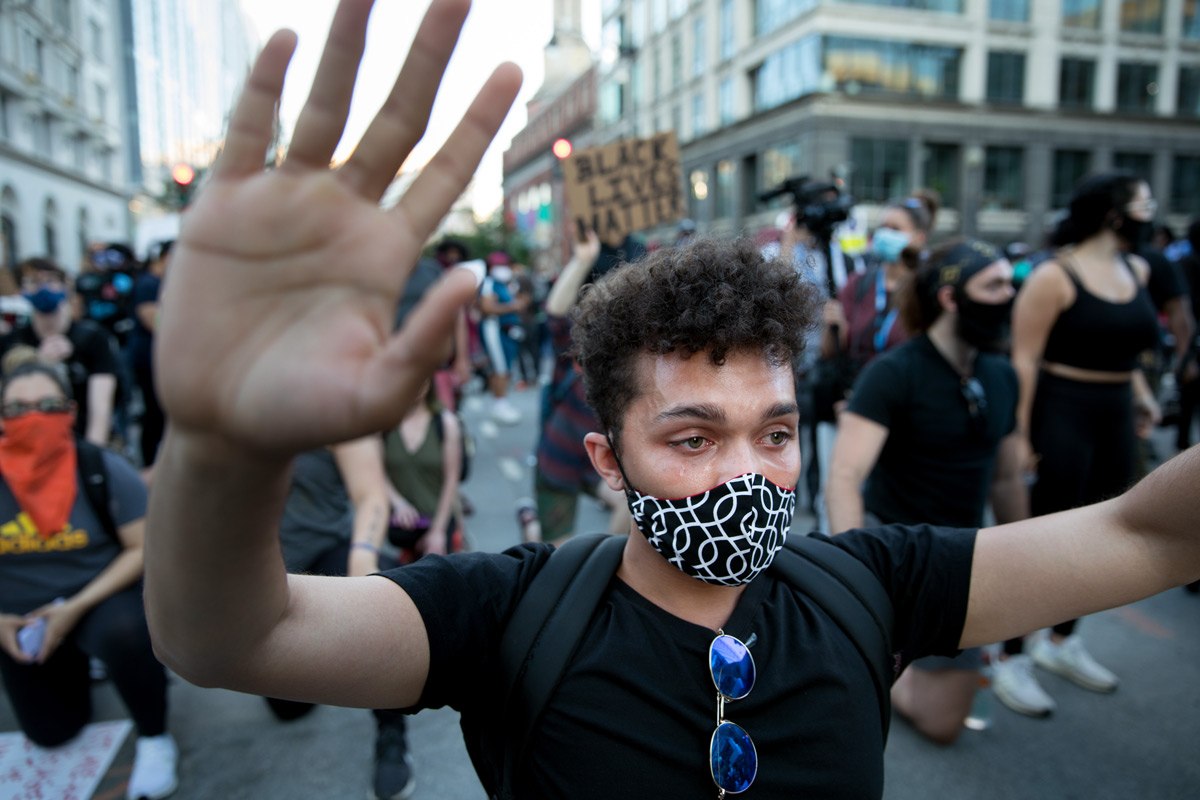
Bradley Brown, 24, of Washington, weeps as he protests the death of George Floyd near the White House where demonstrations rocked the nation's capital for a third night, in Washington, D.C., on Sunday, May 31, 2020. Floyd, a black man, died when a white police officer held his knee on the man's neck during an arrest in Minneapolis. Protesters set cars, shops and the historic St. John's Church on fire and law enforcement shot tear gas, fireworks and used pepper spray against the crowds.
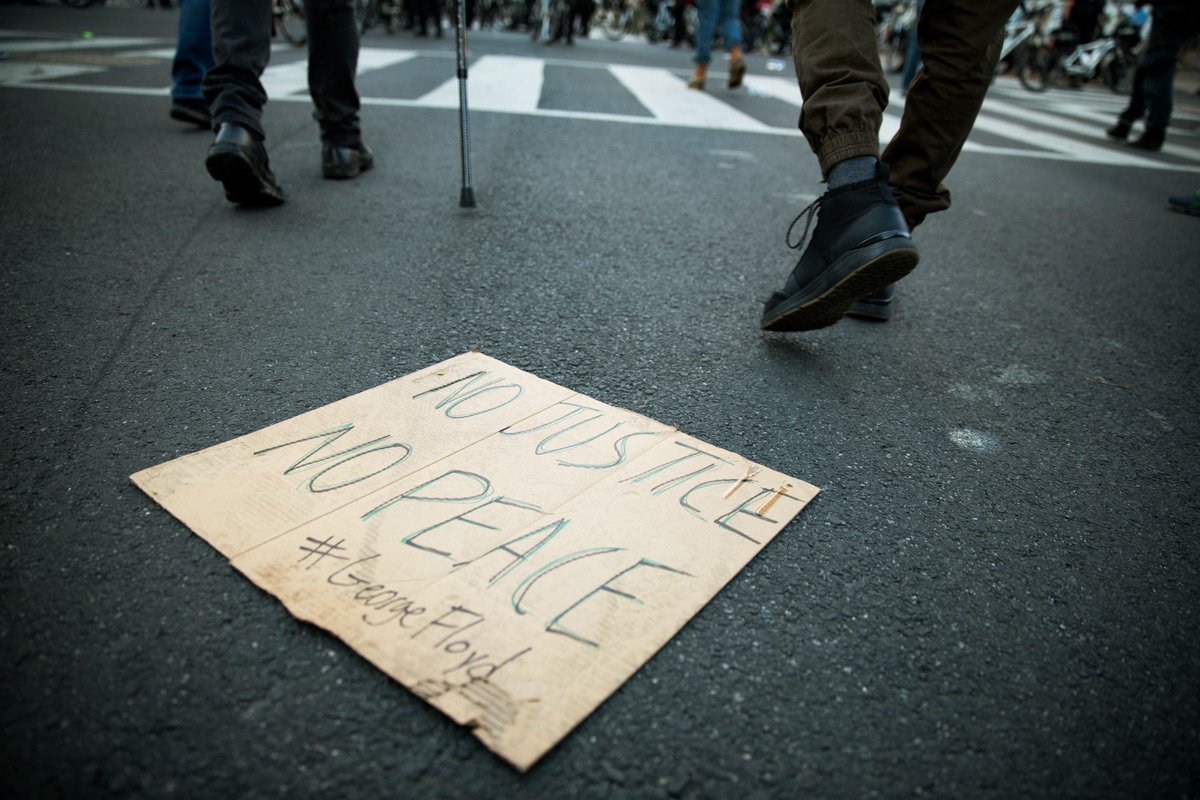
Near the White House, demonstrators peacefully protest the death of George Floyd in Washington, D.C., on Monday, June 1, 2020. Floyd, a black man, died when a white police officer held his knee on the man's neck during an arrest in Minneapolis last week. The military police, National Guard and Washington police aggressively shoved demonstrators and fired stun grenades, sting balls and chemical gas to drive them away from the White House where President Trump then walked to St. John's Church for a photo op.
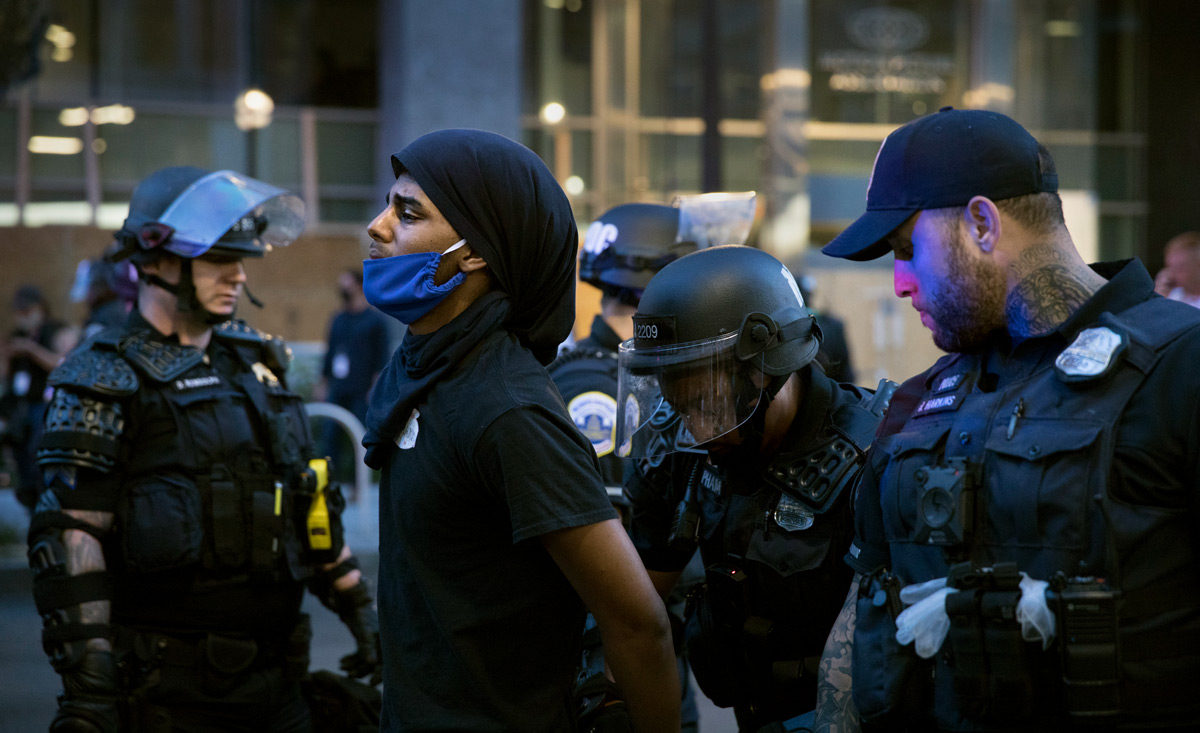
Near the White House, demonstrators peacefully protesting the death of George Floyd are encircled by the police and eventually arrested in Washington, D.C., on Monday, June 1, 2020. Floyd, a black man, died when a white police officer held his knee on the man's neck during an arrest in Minneapolis last week. The military police, National Guard and Washington police aggressively shoved demonstrators and fired stun grenades, sting balls and chemical gas to drive them away from the White House where President Trump then walked to St. John's Church for a photo op.
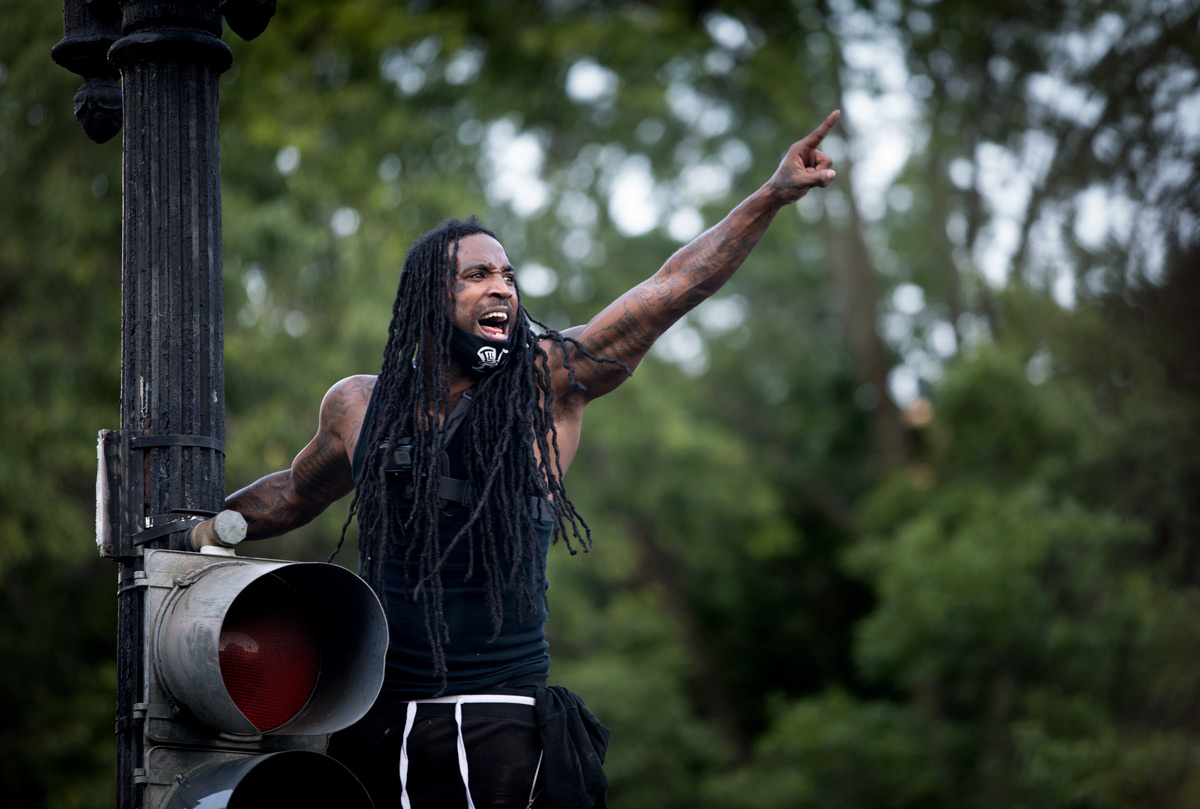
Mike Dangelo addressed the demonstrators atop a traffic light during the George Floyd protests that have gripped the nation's capital near the White House in Washington, D.C., on Tuesday, June 2, 2020. Floyd, a black man, died last week when a white police officer held his knee on the man's neck during an arrest in Minneapolis last week. After yesterday's aggressive tactics by law enforcement to clear Lafayette Park so Trump could have a photo op, the day passed relatively peacefully with several thousand demonstrators chanting and taunting the officers.
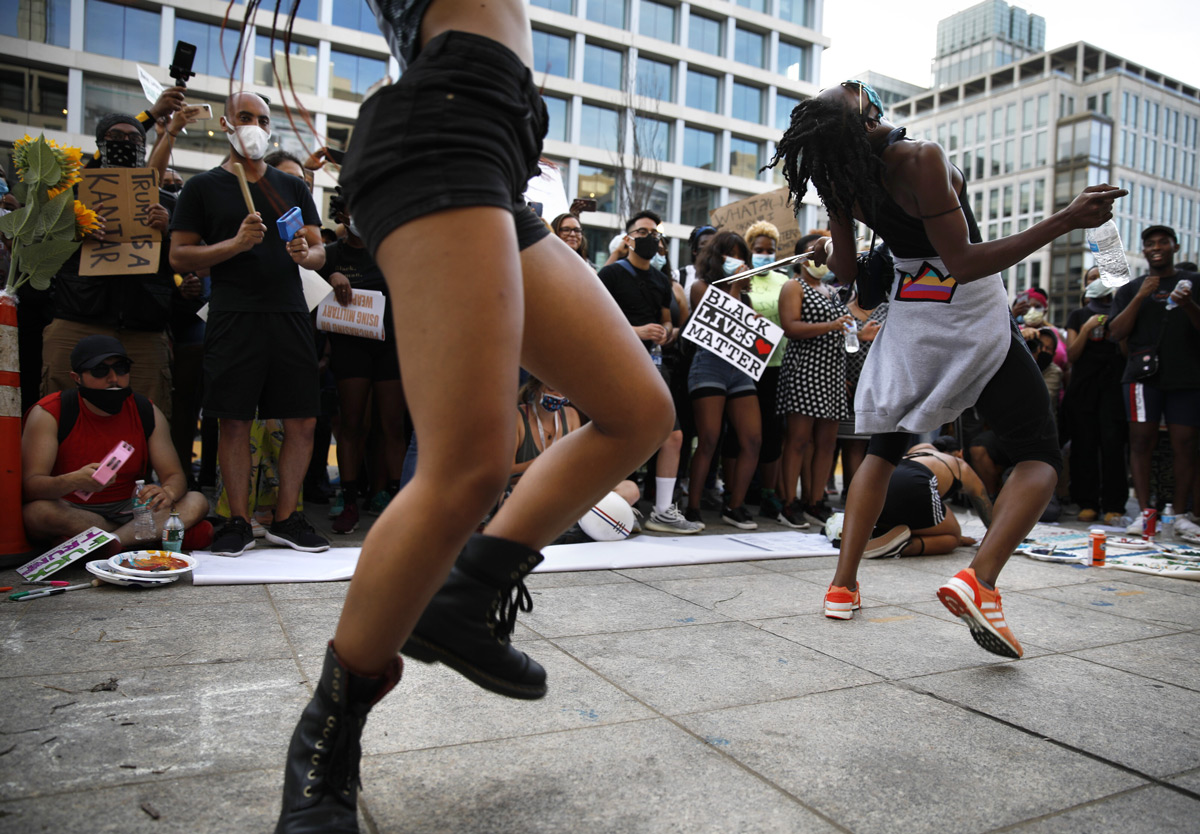
Blake Avenue and Amina Smith, left and right, danced to drums during demonstrations on the newly minted Black Lives Matter Plaza in response to the death of George Floyd and police brutality in Washington, D.C., on Saturday, June 6, 2020. Floyd, a black man, died May 25 when a white police officer held his knee on the man's neck during an arrest in Minneapolis. His death has sparked demonstrations throughout the country and the world.
Hurricane Dorian devastates the Bahamas
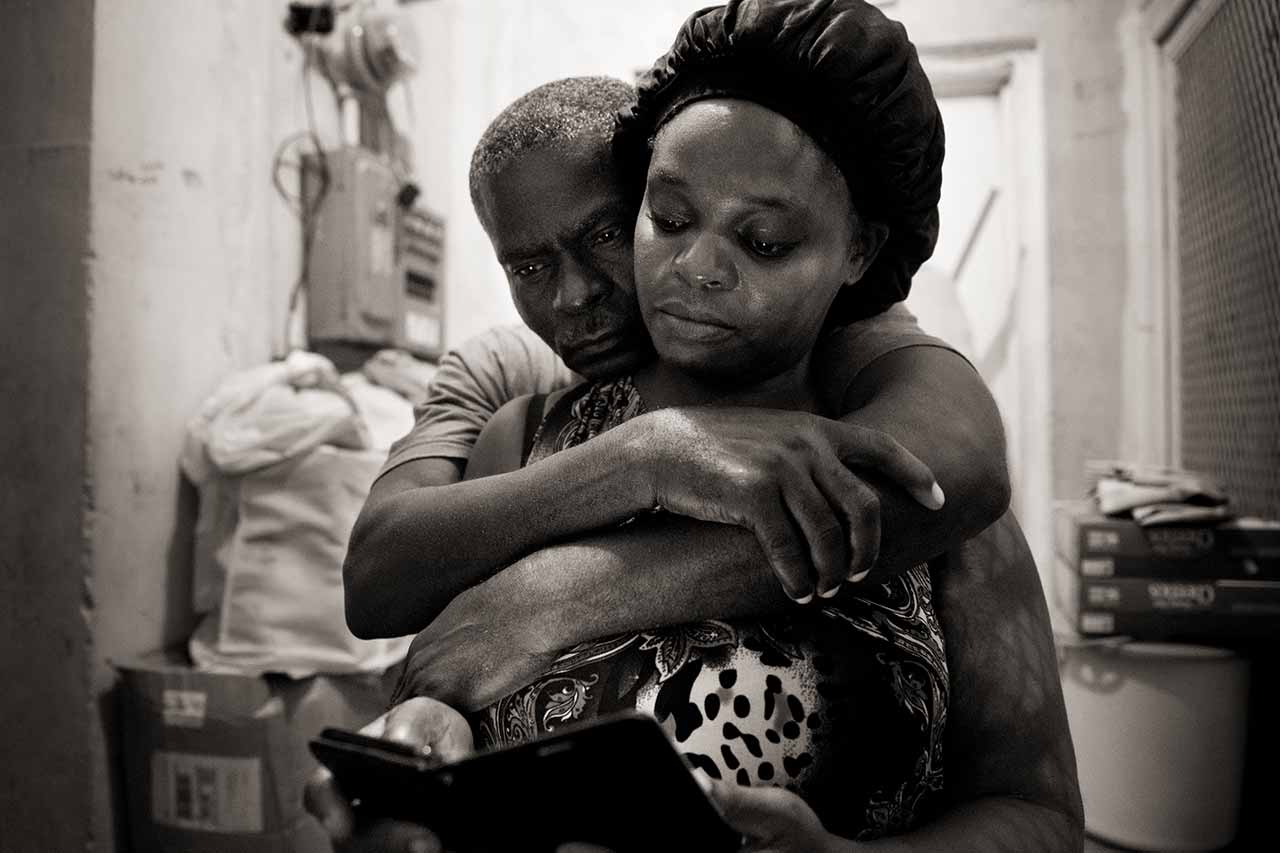
A month after Hurricane Dorian devastated the Bahamas, evacuees Sherrine Petit Homme LaFrance gets a quiet hug from husband Ferrier Petit Homme in Nassau, Bahamas, on Oct. 5, 2019. Petit Homme LaFrance and her family are staying with China Laguerre's family who took in 10 evacuees after the storm--housing, feeding and assisting them with their daily needs. Petit Homme LaFrance was staying at the Breezes Hotel, which was giving shelter to displaced residents, but was kicked out when her 14-year-old son was seen speaking to hotel guests.
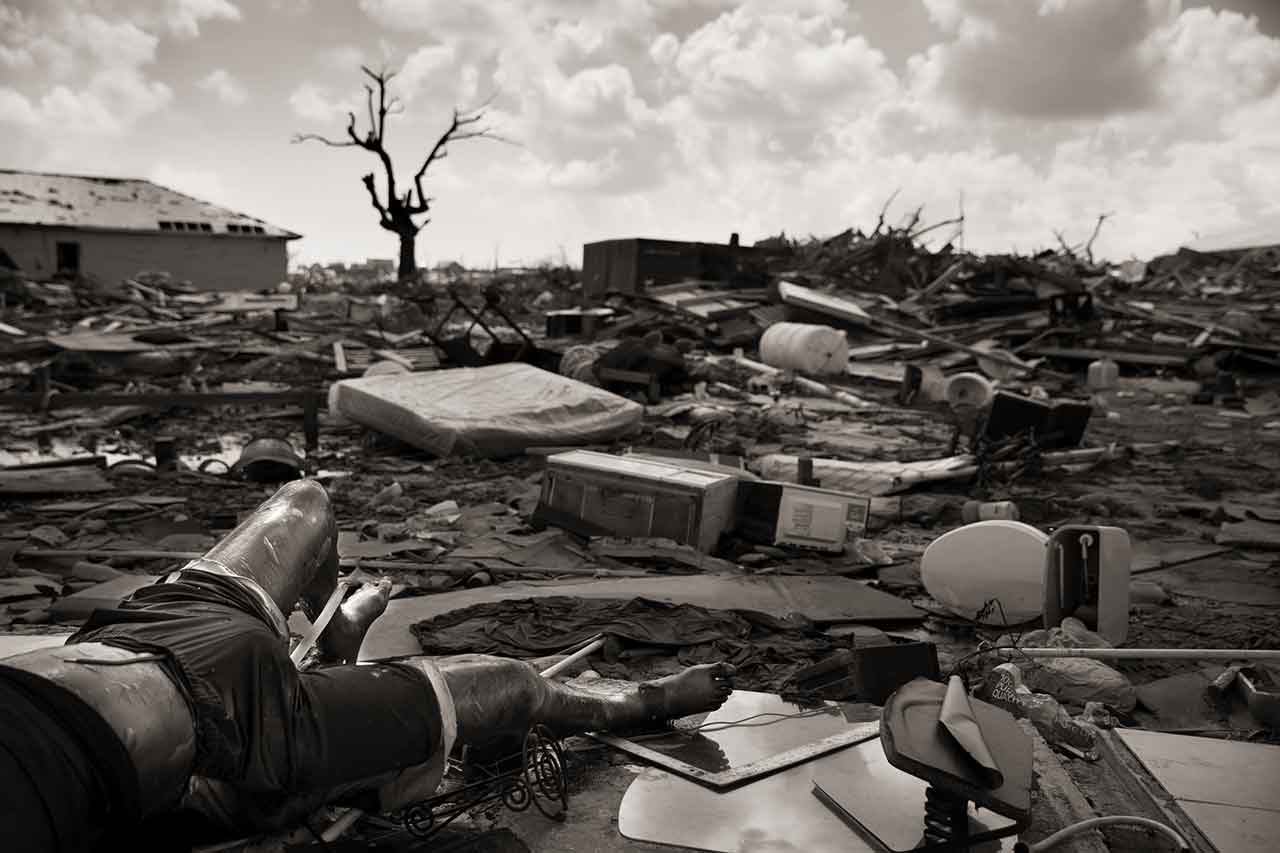
Bodies lay in the debris left by Hurricane Dorian, which decimated the town of Marsh Harbour on Abaco in the Bahamas on Sept. 6, 2019. The Mudd, an immigrant shanty town, is home to about 8,000 Haitians, some of whom have lived in the area for several generations. The number of missing has not been fully accounted as many of the Mudd's residents were undocumented Haitians, a sore point for the Bahamian government.
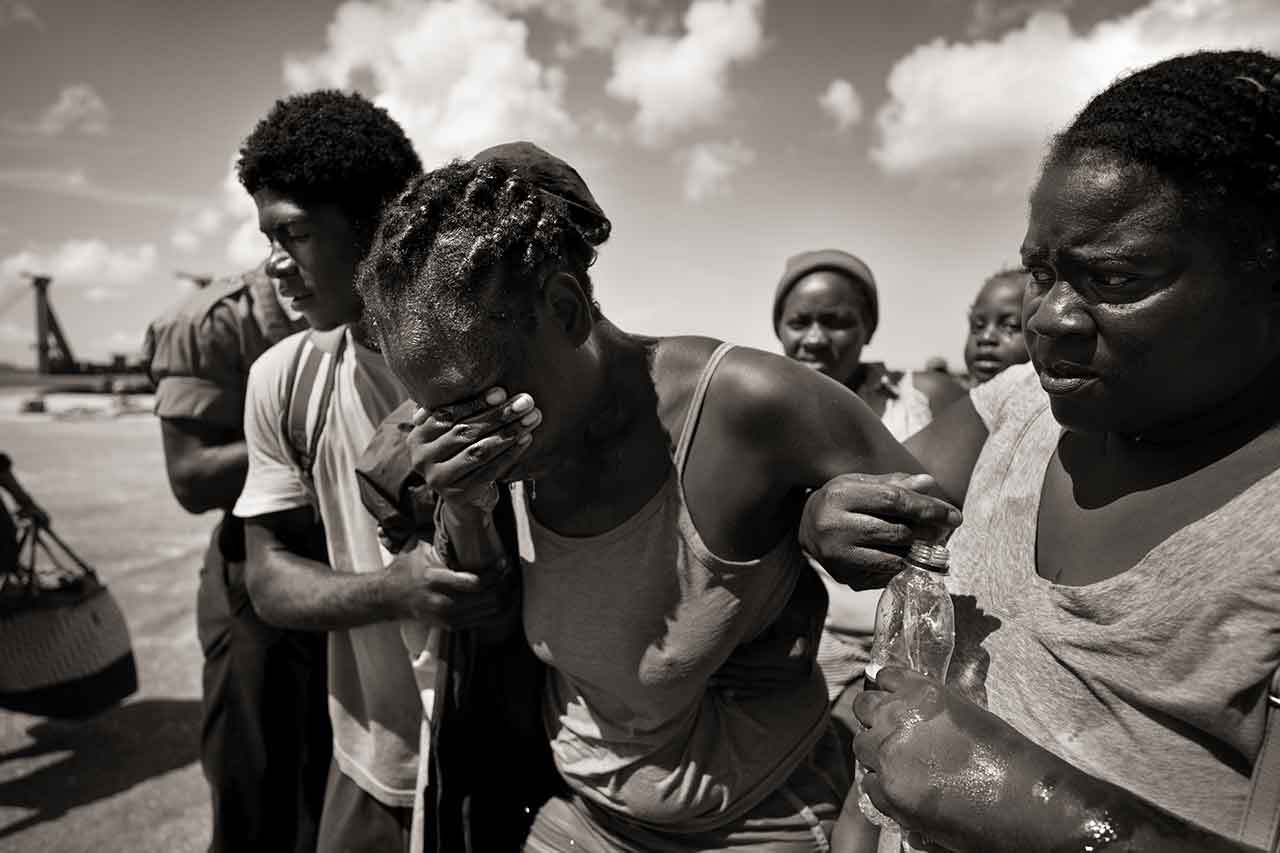
Haitian Nicole Guillaume, who was nursing her 2-year-old son while waiting with several hundred other Haitians and Bahamians at the port of Marsh Harbour, fainted in the heat. Guillaume hopes to board a boat to Nassau after the town was decimated by Hurricane Dorian on Abaco in the Bahamas on Sept. 6, 2019.
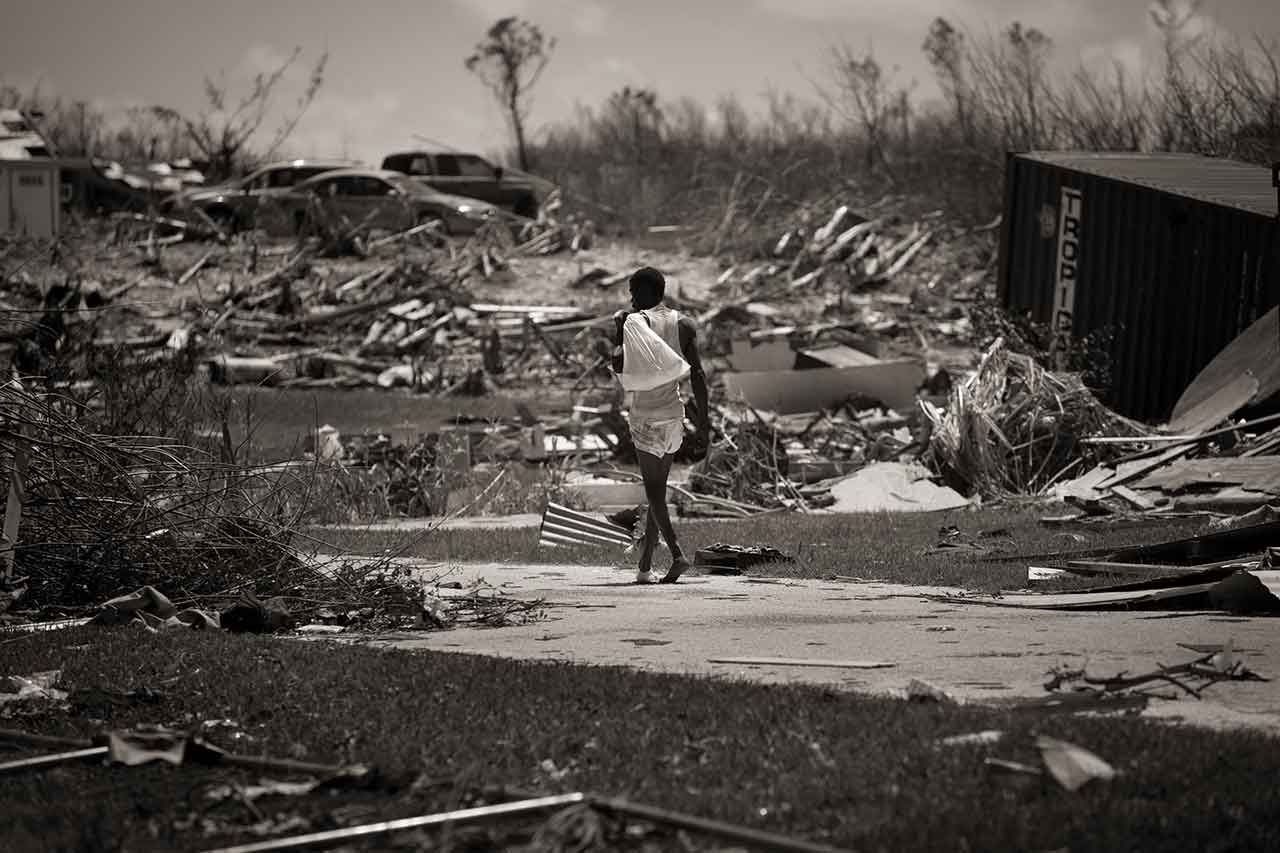
A week after the storm, a man wanders confused through the mangled structures and debris left by Hurricane Dorian in Marsh Harbour after it decimated the island of Abaco in the Bahamas a week ago on Sept. 9, 2019.
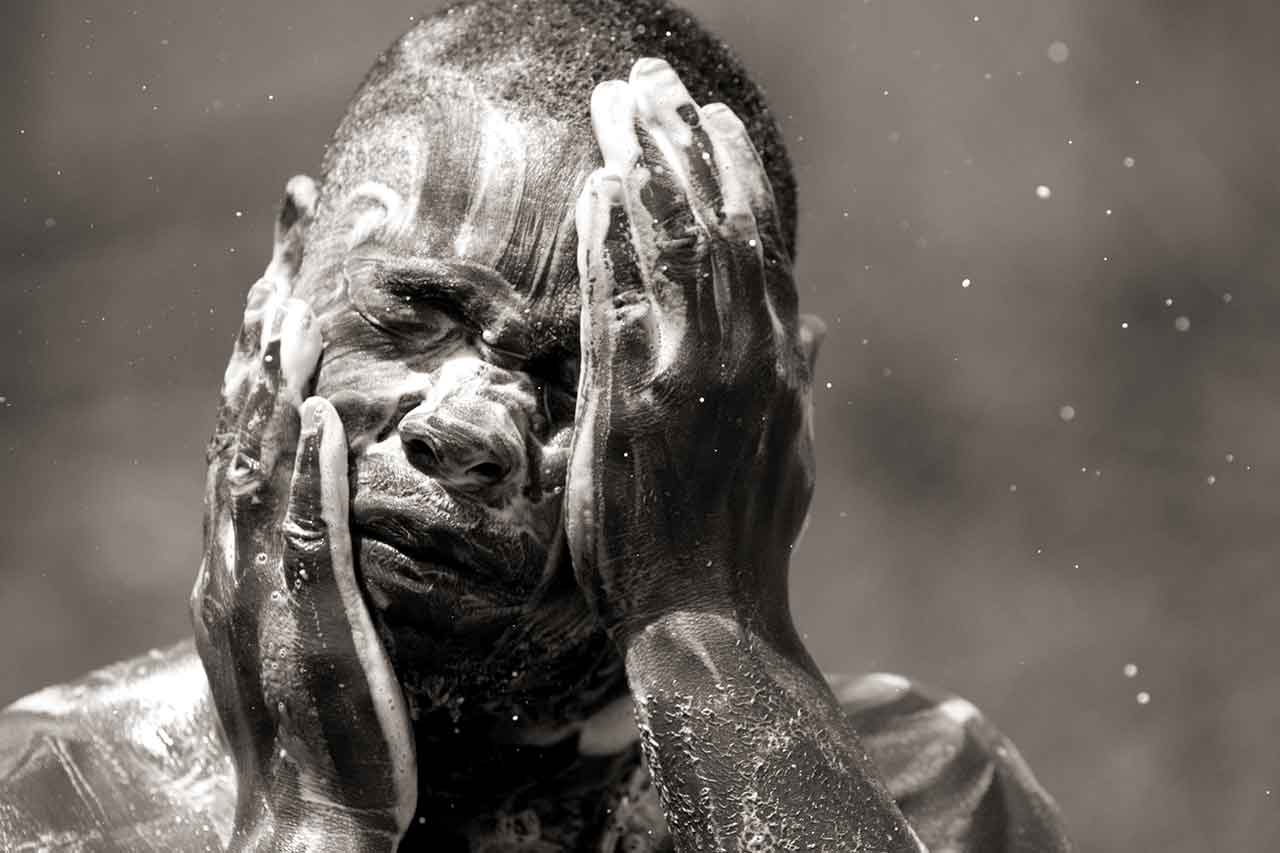
Haitian Leopaul Forestal of Marsh Harbour washes up after the nongovernmental organization World Hope set up a clean water filtration system at the Abaco Primary School on the island of Abaco in the Bahamas on Sept. 8, 2019. Some 50 Haitian evacuees from Hurricane Dorian still remained in the shelter a week after the storm, distrustful of the Bahamian government's promises to care for them, while many others were taking boats and planes to seek shelter in Nassau, the Bahamian capital.
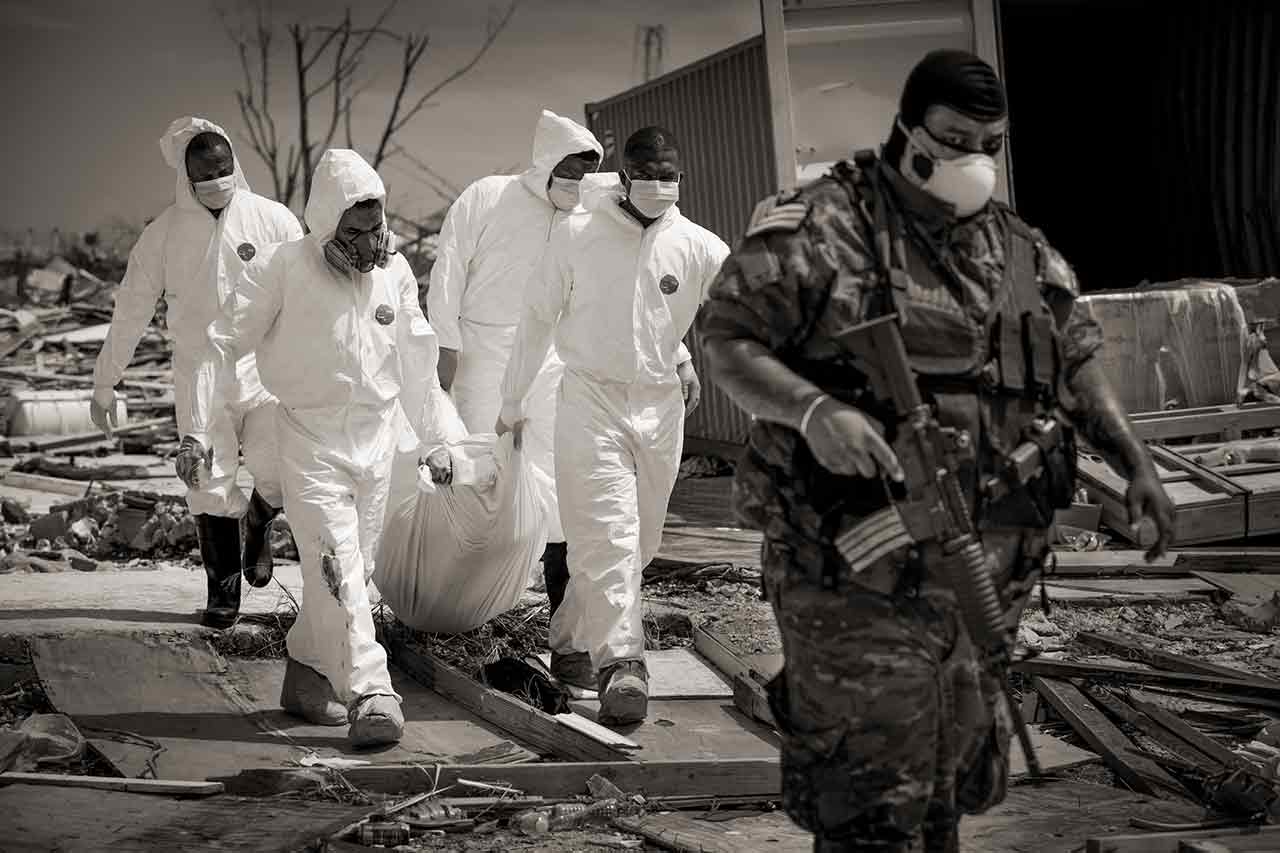
Accompanied by Raian Budhu of the Royal Bahamas Police Force, right, the Bahamian Crime Scene Investigation team removes the body of a man killed during Hurricane Dorian when it hit a week ago in Marsh Harbour on the island of Abaco on Sept. 8, 2019.

The cross that once overlooked Marsh Harbour from the hilltop of St. Francis de Sales Catholic Church lays in the road on the island of Abaco, Bahamas, a week after Hurricane Dorian decimated the town on Sept. 9, 2019.
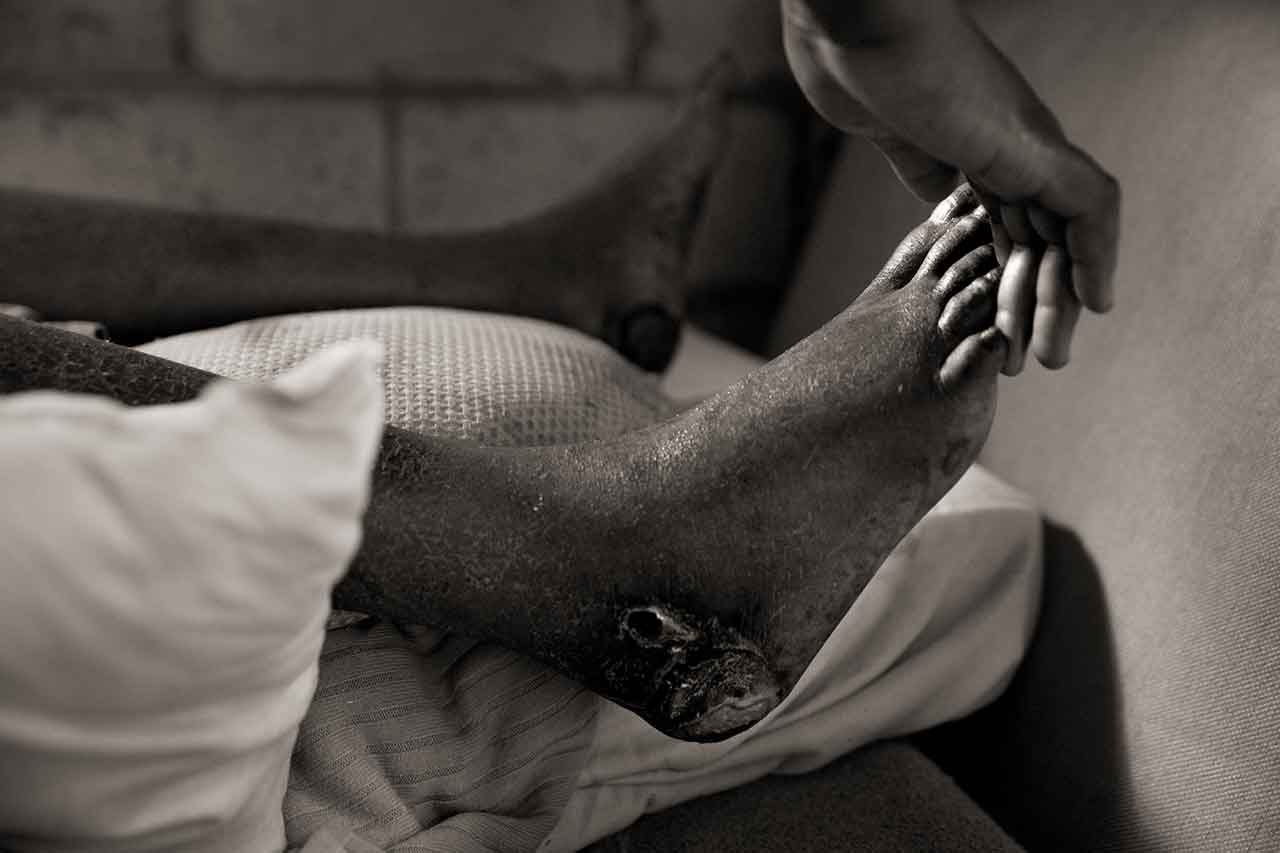
Lacieuse Timothee's sores develop gangrene after she was buried under debris for hours when Hurricane Dorian hit the Bahamas on Sept. 30, 2019. Timothee lays partly paralyzed but cannot afford to buy medication or get treatment; she was turned out from the local hospital after a few days, and was told there was nothing more to be done for her. She died three months later. The Timothee family lived with China Laguerre in Nassau; the family barely surviving on the food stamps provided by the Bahamian government. Laguerre hosted 10 people from four families who had no where to live as shelters were overflowing and other shelters turned people out.
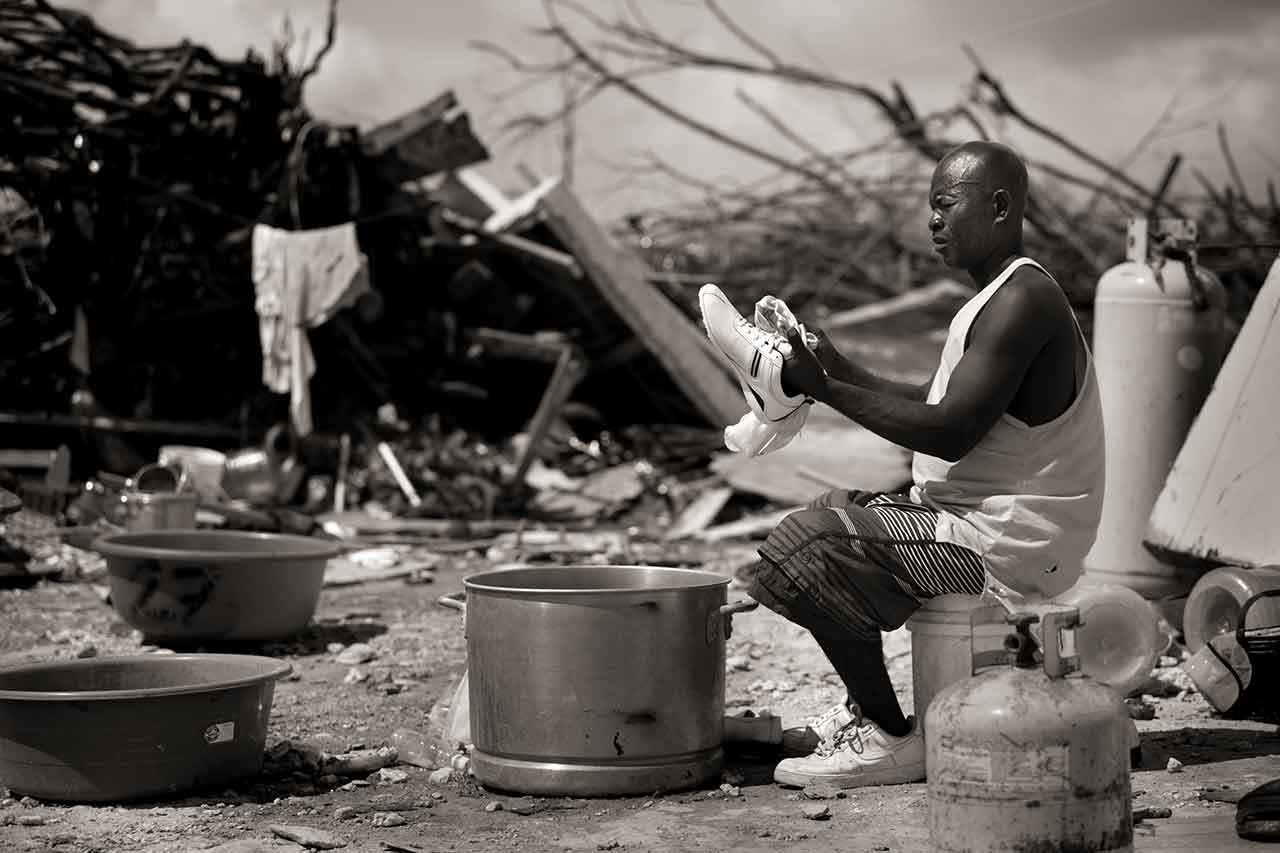
Haitian Manes Lundy wipes off a pair of brand new shoes that he procured after all his belongings were destroyed during Hurricane Dorian in the town of Marsh Harbour on Abaco in the Bahamas on Sept. 6, 2019. The Mudd, an immigrant shanty town, is home to about 8,000 Haitians, some of whom have lived in the area for several generations. "I have plenty of family dead here," said Lundy. That is the body of my cousin Doudoune Manes, but I don't have a way to bury her," he pointed to a visitor.
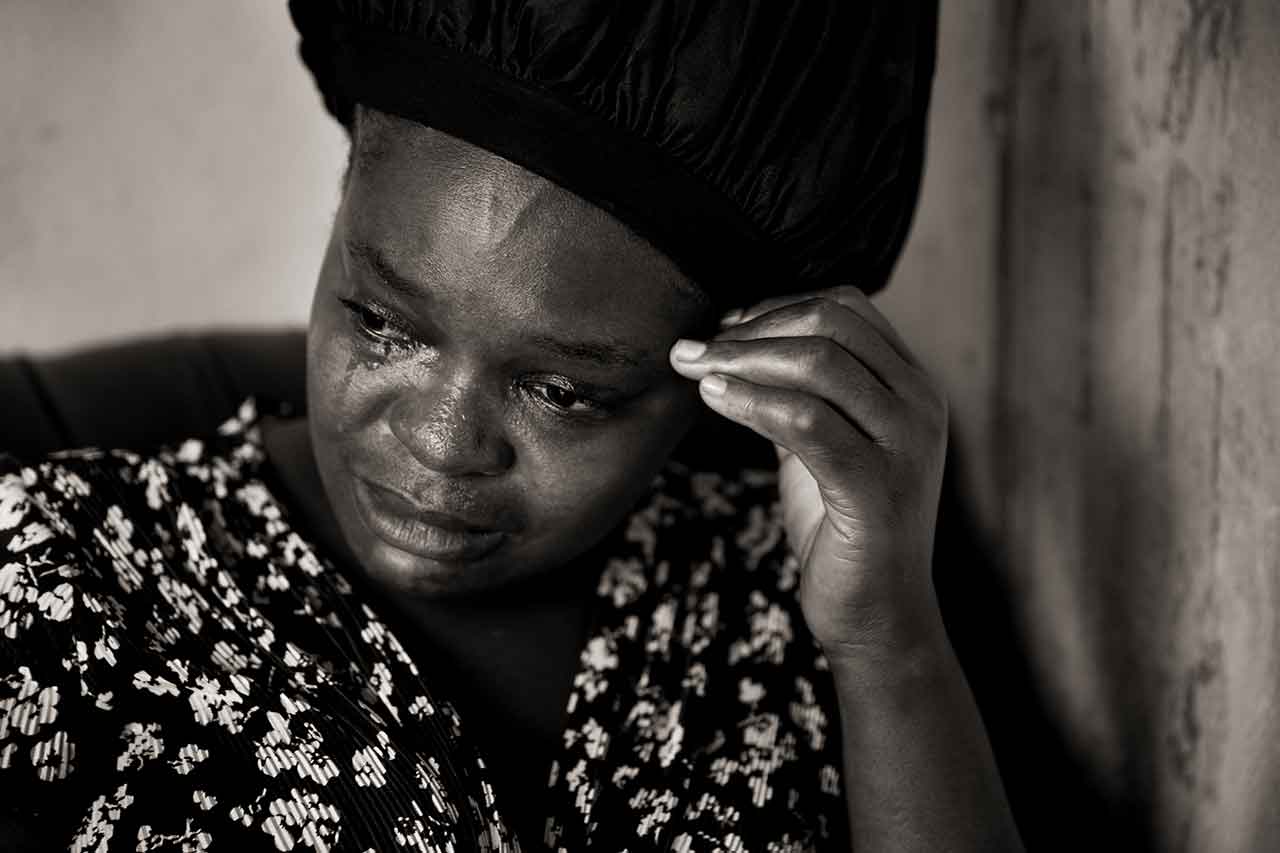
Evacuee Sherrine Petit Homme LaFrance weeps as she recounts how her relatives who live in Nassau turned their backs on helping her after her home was decimated by Hurricane Dorian, in Nassau, Bahamas, on Oct. 3, 2019. Petit Homme LaFrance had just moved in to her newly constructed house in Treasure Cay on Abaco the day before the storm hit, only to see it decimated by Dorian the same night.

Several hundred desperate Haitians and Bahamians wait at the port of Marsh Harbour in the hopes of boarding a boat to Nassau after the town was decimated by Hurricane Dorian on Abaco, Bahamas, on Sept. 6, 2019.

A month after Hurricane Dorian devastated the Bahamas, Abaco evacuees Justin Bain, 14, and his parents Sherrine Petit Homme LaFrance and Ferrier Petit Homme, left to right, sleep on available space in China Laguerre's home in Nassau, Bahamas, on Oct. 5, 2019. Laguerre's family took in 10 evacuees after the storm--housing, feeding and assisting them with their daily needs.
The 185 mph winds tore up the town of Marsh Harbour, where days later bodies were being excavated from the debris. Scientists agree that climate change is causing storms to form more quickly and more powerfully, with unprecedented damage, greater rainfall and flooding, and increased fatalities. On Abaco island, thousands of undocumented Haitian immigrants work and live. Their shanty town was the epicenter of damage as water surged 10 feet taking all in its wake. Evacuees found a warm welcome from fellow Haitians like China Laguerre, who housed, fed and assisted 10 evacuees for several weeks after the storm.
Gallery
[supsystic-gallery id='5']
